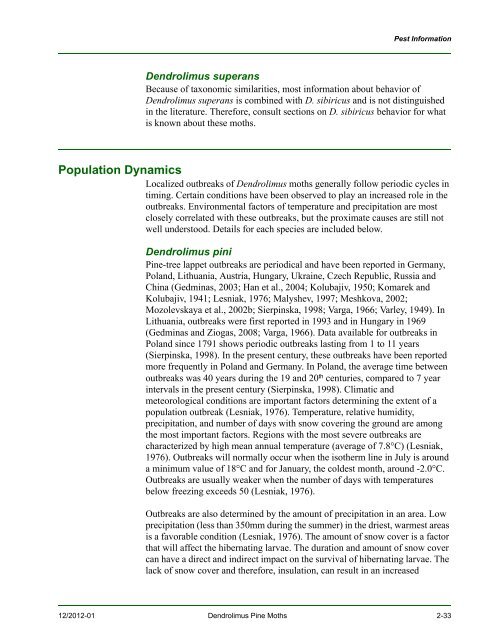New Pest Response Guidelines - aphis - US Department of Agriculture
New Pest Response Guidelines - aphis - US Department of Agriculture
New Pest Response Guidelines - aphis - US Department of Agriculture
Create successful ePaper yourself
Turn your PDF publications into a flip-book with our unique Google optimized e-Paper software.
<strong>Pest</strong> Information<br />
Dendrolimus superans<br />
Because <strong>of</strong> taxonomic similarities, most information about behavior <strong>of</strong><br />
Dendrolimus superans is combined with D. sibiricus and is not distinguished<br />
in the literature. Therefore, consult sections on D. sibiricus behavior for what<br />
is known about these moths.<br />
Population Dynamics<br />
Localized outbreaks <strong>of</strong> Dendrolimus moths generally follow periodic cycles in<br />
timing. Certain conditions have been observed to play an increased role in the<br />
outbreaks. Environmental factors <strong>of</strong> temperature and precipitation are most<br />
closely correlated with these outbreaks, but the proximate causes are still not<br />
well understood. Details for each species are included below.<br />
Dendrolimus pini<br />
Pine-tree lappet outbreaks are periodical and have been reported in Germany,<br />
Poland, Lithuania, Austria, Hungary, Ukraine, Czech Republic, Russia and<br />
China (Gedminas, 2003; Han et al., 2004; Kolubajiv, 1950; Komarek and<br />
Kolubajiv, 1941; Lesniak, 1976; Malyshev, 1997; Meshkova, 2002;<br />
Mozolevskaya et al., 2002b; Sierpinska, 1998; Varga, 1966; Varley, 1949). In<br />
Lithuania, outbreaks were first reported in 1993 and in Hungary in 1969<br />
(Gedminas and Ziogas, 2008; Varga, 1966). Data available for outbreaks in<br />
Poland since 1791 shows periodic outbreaks lasting from 1 to 11 years<br />
(Sierpinska, 1998). In the present century, these outbreaks have been reported<br />
more frequently in Poland and Germany. In Poland, the average time between<br />
outbreaks was 40 years during the 19 and 20 th centuries, compared to 7 year<br />
intervals in the present century (Sierpinska, 1998). Climatic and<br />
meteorological conditions are important factors determining the extent <strong>of</strong> a<br />
population outbreak (Lesniak, 1976). Temperature, relative humidity,<br />
precipitation, and number <strong>of</strong> days with snow covering the ground are among<br />
the most important factors. Regions with the most severe outbreaks are<br />
characterized by high mean annual temperature (average <strong>of</strong> 7.8°C) (Lesniak,<br />
1976). Outbreaks will normally occur when the isotherm line in July is around<br />
a minimum value <strong>of</strong> 18°C and for January, the coldest month, around -2.0°C.<br />
Outbreaks are usually weaker when the number <strong>of</strong> days with temperatures<br />
below freezing exceeds 50 (Lesniak, 1976).<br />
Outbreaks are also determined by the amount <strong>of</strong> precipitation in an area. Low<br />
precipitation (less than 350mm during the summer) in the driest, warmest areas<br />
is a favorable condition (Lesniak, 1976). The amount <strong>of</strong> snow cover is a factor<br />
that will affect the hibernating larvae. The duration and amount <strong>of</strong> snow cover<br />
can have a direct and indirect impact on the survival <strong>of</strong> hibernating larvae. The<br />
lack <strong>of</strong> snow cover and therefore, insulation, can result in an increased<br />
12/2012-01 Dendrolimus Pine Moths 2-33

















